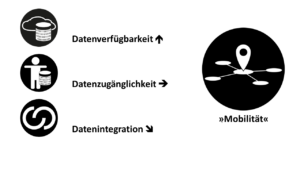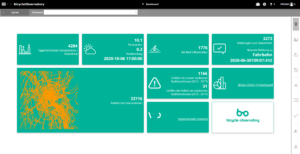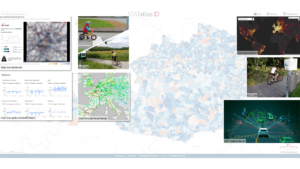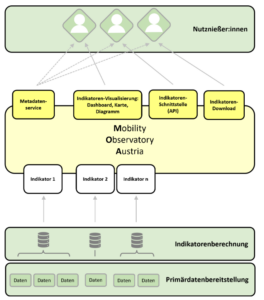Mobility Observatory Austria: Better data enables sustainable cycling promotion

The KOMOA concept study for a Mobility Observatory Austria shows how systemic approaches using a variety of data can help with the current challenges of transportation planning. How can it meet mobility needs while minimizing the negative ecological, social and economic effects of transport? The two Cycle Competence members, the University of Salzburg and Salzburg Research, have been researching the digitalization of bicycle mobility for many years. Together with partners from the Cycle Competence Network (PRISMA solutions, HERRY Consult, AIT), they have created KOMOA for the Ministry of Climate Protection. We provide initial insights and background information.
Data on various aspects of cycling is scarce
Although cycling is playing an increasingly central role in all mobility strategies and digitalization is advancing at a fast pace, cycling mobility in all its complexity is still almost impossible to capture in terms of data. The simple question: “When do how many cyclists ride where on the network?” remains unanswered in the vast majority of cases. If the question is taken further – “What types of cyclists are on the road and with what motivation?” – you usually get clueless looks. However, it is precisely these kinds of questions that are of great importance for the targeted promotion of cycling. The interest in spatially and temporally high-resolution data on bicycle mobility is correspondingly high.
Technical architecture for monitoring bicycle mobility
In 2020, the University of Salzburg and the state research organization Salzburg Research developed the concept for a “Bicycle Observatory” together with partners such as the Cyle Competence member PRISMA solutions. Among other things, this involves the necessary technical architecture for integrated, systemic monitoring of bicycle mobility on a local scale. The challenge here is to skillfully link the different data sources, each of which represents an aspect of the multi-layered phenomenon of bicycle mobility. The core competencies of the two research institutions in the field of data modeling and interface design are of great importance here.
In addition to this highly technical approach, the organization and management of the data and its linking must also be optimized accordingly. Questions of data ownership, the associated licenses, update cycles or the storage strategy (centralized vs. decentralized) must be clarified. While technical and organizational issues for a “Bicycle Observatory” have largely been successfully addressed, the availability and accessibility of up-to-date, high-resolution bicycle traffic data is the biggest bottleneck for the implementation of a “Bicycle Observatory”.
KOMOA researches data bases with relevance for personal mobility
Based on the results of the “Bicycle Observatory” study, the two Salzburg research partners, together with other partners from the Cycle Competence network such as PRISMA solutions, HERRY Consult and AIT, prepared a comprehensive concept study for a “Mobility Observatory Austria” for the Ministry of Climate Protection (BMK). In this wider context, a lot of space was given to cycling as a key pillar of the mobility transition. Both the Mobility Master Plan 2030 and the Digital Transformation in Mobility Action Plan (AP-DTM) provide for continuous monitoring of the mobility system.
What is particularly interesting about the concept study for a “Mobility Observatory” is the identified need for digital data in the planning and management of sustainable mobility systems, as well as in mobility research. Of over 100 experts surveyed, only around a third are able to perform their tasks well with the data and information products currently available. How this need can be addressed with the help of a “Mobility Observatory” can be read in the recently published concept study.
What can a Mobility Observatory Austria do?
According to the study (page 30), in order to best meet the needs of the beneficiaries, an MOA includes at least the following service functionalities, whereby transparency in data processing is mandatory:
– Metadata service for querying the spatial and temporal availability of indicators, for information on the origin, processing, quality and other properties of the data.
– Visualization of indicators in a dashboard, in web maps and diagrams
– Programming interface (API) for querying indicators using software applications
– Download of indicators, e.g. as CSV, JSON file or geopackage/shapefile (manual) for further use in other programs
Outline of the information flow in an MOA (Figure 11 of the study)
Who benefits from a Mobility Observatory Austria?
According to the study (page 39), the beneficiaries of an MOA can be summarized in the following groups:
1. demand and decision makers from administration and politics
2. transport and service planners, consultants
3. science and research
4. providers of mobility services such as transport companies, transport associations, etc.
5. providers of mobility data such as mobile network operators
6. association or citizens’ initiative
7. interest groups or NGOs
8. many other players such as the climate and energy model regions (KEM) or tourism communities
Descriptions of exemplary personae from the study (Figures 13-15)
Cooperation is welcome!
For the University of Salzburg and Salzburg Research, Cycle Competence Austria represents an ideal environment for further research into bicycle mobility and its digital representation. Together with companies that collect and process data and develop digital tools and information products, we can work on reducing the blank spots on the data map and actively promote innovation. Do you have ideas for joint projects or questions? Do not hesitate to get in touch with us!
– Download KOMOA concept study
Anyone interested can read this series of articles on the subject of data and cycling on the Gis.Point portal:
– Cycling dashboard: Everything at a glance (Brocza, Ulrike; Kollarits, Stefan)
– Mission Impossible: Typologization of cyclists – a design-sociological approach (Heym, Laura; Werner, Christian; Innerebner, Günther; Kofler, Patrick)
– Experiences with the implementation of a data management plan for spatial cycling data (Leitinger, Sven; Wagner, Andreas; Kremser, Wolfgang)
– Bicycle Observatory – a spatially differentiated, continuous observation of bicycle mobility (Loidl, Martin; Wagner, Andreas; Kaziyeva, Dana; Zagel, Bernhard)
Cycling Competence Members in this article:
More articles with this member:
[crp]
Share this article:
Mobility Observatory Austria: Better data enables sustainable cycling promotion
Share this article:

The KOMOA concept study for a Mobility Observatory Austria shows how systemic approaches using a variety of data can help with the current challenges of transportation planning. How can it meet mobility needs while minimizing the negative ecological, social and economic effects of transport? The two Cycle Competence members, the University of Salzburg and Salzburg Research, have been researching the digitalization of bicycle mobility for many years. Together with partners from the Cycle Competence Network (PRISMA solutions, HERRY Consult, AIT), they have created KOMOA for the Ministry of Climate Protection. We provide initial insights and background information.
Data on various aspects of cycling is scarce
Although cycling is playing an increasingly central role in all mobility strategies and digitalization is advancing at a fast pace, cycling mobility in all its complexity is still almost impossible to capture in terms of data. The simple question: “When do how many cyclists ride where on the network?” remains unanswered in the vast majority of cases. If the question is taken further – “What types of cyclists are on the road and with what motivation?” – you usually get clueless looks. However, it is precisely these kinds of questions that are of great importance for the targeted promotion of cycling. The interest in spatially and temporally high-resolution data on bicycle mobility is correspondingly high.
Technical architecture for monitoring bicycle mobility
In 2020, the University of Salzburg and the state research organization Salzburg Research developed the concept for a “Bicycle Observatory” together with partners such as the Cyle Competence member PRISMA solutions. Among other things, this involves the necessary technical architecture for integrated, systemic monitoring of bicycle mobility on a local scale. The challenge here is to skillfully link the different data sources, each of which represents an aspect of the multi-layered phenomenon of bicycle mobility. The core competencies of the two research institutions in the field of data modeling and interface design are of great importance here.
In addition to this highly technical approach, the organization and management of the data and its linking must also be optimized accordingly. Questions of data ownership, the associated licenses, update cycles or the storage strategy (centralized vs. decentralized) must be clarified. While technical and organizational issues for a “Bicycle Observatory” have largely been successfully addressed, the availability and accessibility of up-to-date, high-resolution bicycle traffic data is the biggest bottleneck for the implementation of a “Bicycle Observatory”.
KOMOA researches data bases with relevance for personal mobility
Based on the results of the “Bicycle Observatory” study, the two Salzburg research partners, together with other partners from the Cycle Competence network such as PRISMA solutions, HERRY Consult and AIT, prepared a comprehensive concept study for a “Mobility Observatory Austria” for the Ministry of Climate Protection (BMK). In this wider context, a lot of space was given to cycling as a key pillar of the mobility transition. Both the Mobility Master Plan 2030 and the Digital Transformation in Mobility Action Plan (AP-DTM) provide for continuous monitoring of the mobility system.
What is particularly interesting about the concept study for a “Mobility Observatory” is the identified need for digital data in the planning and management of sustainable mobility systems, as well as in mobility research. Of over 100 experts surveyed, only around a third are able to perform their tasks well with the data and information products currently available. How this need can be addressed with the help of a “Mobility Observatory” can be read in the recently published concept study.
What can a Mobility Observatory Austria do?
According to the study (page 30), in order to best meet the needs of the beneficiaries, an MOA includes at least the following service functionalities, whereby transparency in data processing is mandatory:
– Metadata service for querying the spatial and temporal availability of indicators, for information on the origin, processing, quality and other properties of the data.
– Visualization of indicators in a dashboard, in web maps and diagrams
– Programming interface (API) for querying indicators using software applications
– Download of indicators, e.g. as CSV, JSON file or geopackage/shapefile (manual) for further use in other programs
Outline of the information flow in an MOA (Figure 11 of the study)
Who benefits from a Mobility Observatory Austria?
According to the study (page 39), the beneficiaries of an MOA can be summarized in the following groups:
1. demand and decision makers from administration and politics
2. transport and service planners, consultants
3. science and research
4. providers of mobility services such as transport companies, transport associations, etc.
5. providers of mobility data such as mobile network operators
6. association or citizens’ initiative
7. interest groups or NGOs
8. many other players such as the climate and energy model regions (KEM) or tourism communities
Descriptions of exemplary personae from the study (Figures 13-15)
Cooperation is welcome!
For the University of Salzburg and Salzburg Research, Cycle Competence Austria represents an ideal environment for further research into bicycle mobility and its digital representation. Together with companies that collect and process data and develop digital tools and information products, we can work on reducing the blank spots on the data map and actively promote innovation. Do you have ideas for joint projects or questions? Do not hesitate to get in touch with us!
– Download KOMOA concept study
Anyone interested can read this series of articles on the subject of data and cycling on the Gis.Point portal:
– Cycling dashboard: Everything at a glance (Brocza, Ulrike; Kollarits, Stefan)
– Mission Impossible: Typologization of cyclists – a design-sociological approach (Heym, Laura; Werner, Christian; Innerebner, Günther; Kofler, Patrick)
– Experiences with the implementation of a data management plan for spatial cycling data (Leitinger, Sven; Wagner, Andreas; Kremser, Wolfgang)
– Bicycle Observatory – a spatially differentiated, continuous observation of bicycle mobility (Loidl, Martin; Wagner, Andreas; Kaziyeva, Dana; Zagel, Bernhard)
Cycling Competence Members in this article:
More articles with this member:
[crp]





